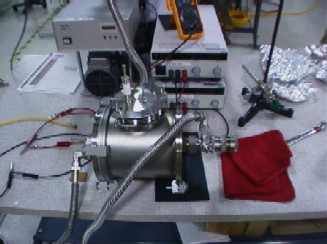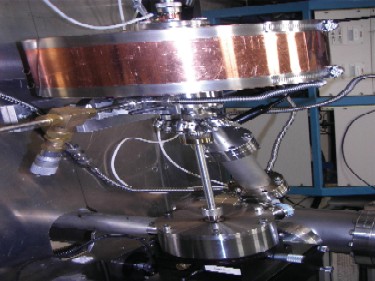
Not much detail is visible, but this small hydrogen generator is in use now on 20 hydrino reactors running at BlackLight Power's headquarters in New Jersey. Photo: BlackLight Power Co.
2:41 AM, March 23, 2010 -- For HHO developers, the hydrino cell stack from BlackLight Power Co.will mean a market just in the United States for 200 million standard automobile hydrogen PEM cell generators, and perhaps another 50 million for ships, trains, planes, rockets, buses, trucks, heavy equipment and everything else that requires fuel to move.
But hydrino engines, which may be in limited production now, and their marriage to HHO PEM cells might take a decade to perfect, but California's Chava Energy expects to have a prototype within a year and to marry it to a hydrino-like cell stack a year or so later. Imagine Henry Ford's first vehicle, the product of years of tinkering before it began rolling off the assembly line, which Ford also had to invent: that is the scale of the challenge to HHO PEM cell developers who want to link up with hydrino cars.
The hydrino cars basically consist of a transmission, electric motor, engine control system, a CIHT cell stack (where hydrinos are created) and a hydrogen generator.
There is no carburetor nor fuel injection system except for injecting output from the onboard hydrogen generator into the hydrino cell stacks. Because it will be somewhat lighter - and not perhaps not as balanced due to the placement of components - its frame may have to be far stronger than most are now because there's so little space taken up by components under the hood.
The weight of the 200-liter cell stack is about 440 pounds, half that of a conventional engine, requiring just a one-liter water reservoir; no conversion is needed, as that liter of water will provide sufficient electricity to power the electric motor for 1,500 miles.
The cell stacks will be regenerated by the hydrino fuel. The tires are conventional, as are the dashboard and accessories.
The hydrino CIHT stack is expected to cost about $4,600, the transmission $2,000, control electronics $1,800, and electric motors $1,400. All in all, before the frame, dash, trunk, seating and steering components, the car will cost developers about $9,800 each and a basic model could sell in the $15,000-16,000 range.
To see a representation of the concept car, go to the BlackLight engineering presentation and scroll to the very last page (Page 14). If you would like to order an engine, please contact me at hydrino@hhogames.com.
I suspect a large number of orders will be needed to add to the company's focus, which is now primarily on large hydrino reactors, for which they have more than $600 million in pending contracts and $71 million in private investments.

